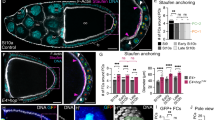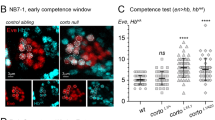Abstract
A small set of maternal genes controls the basic longitudinal pattern of the Drosophila embryo. For the posterior pattern, five genes are necessary both for abdominal segmentation and for pole cell formation1–3. Cytoplasmic transplantations involving oskar (osk) mutant embryos have suggested that the pole plasm serves as a source of a signal required in the more anterior abdominal region3. Here we present evidence that the maternal gene pumilio (pum) is involved in the transport of this signal to the abdominal region. In pum embryos (that is, embryos from females of genotype pum /pum) only the abdomen is affected, whereas the pole plasm seems normal. Transplantation experiments reveal that pum pole plasm contains the abdominal signal but that it cannot reach the target site, the abdomen. Abdominal segmentation is restored when the physical separation between pole plasm and abdominal region is overcome either by transplantation of pum pole plasm into the abdominal region of pum embryos or by genetic means in double mutants with torsolike (in mutant torsolike embryos the abdominal region is juxtaposed to the pole plasm).
Similar content being viewed by others
References
Boswell, R. E. & Mahowald, A. P. Cell 43, 97–104 (1985).
Schüpbach, T. & Wieschaus, E. Wilhelm Roux Arch. dev. Biol. 195, 302–317 (1986).
Lehmann, R. & Nüsslein-Volhard, C. Cell 47, 141–152 (1986).
Nüsslein-Volhard, C. & Wieschaus, E. Nature 287, 795–801 (1980).
Lehmann, R. thesis; Univ. Tübingen (1985).
Mahowald, A. P. J. exp. Zool. 151, 201–215 (1962).
Degelmann, H., Hardy, P. A., Perrimon, N. & Mahowald, A. P. Devl Biol. 115, 479–489 (1986).
Strecker, T. R., Kongsuwan, K., Lengyel, J. A. & Merriam, J. R. Devl Biol. 113, 64–76 (1986).
Schnapp, B. J., Vale, R. D., Sheetz, M. P. & Reese, T. S. Cell 40, 455–462 (1985).
Johnson, K. A. & Borisy, G. G. J. molec. Biol. 133, 199–216 (1979).
Natzle, J. E. & McCarthy, B. J. Devl Biol. 104, 187–198 (1984).
Lehmann, R. & Nüsslein-Volhard, C. Devl Biol. 119, 402–417 (1987).
Perrimon, N., Mohler, D., Engstrom, L. & Mahowald, A. P. Genetics 113, 695–712 (1986).
Lohs-Schardin, M., Cremer, C. & Nüsslein-Volhard, C. Devl Biol. 73, 239–255 (1979).
Jürgens, G., Lehmann, R., Schardin, M. & Nüsslein–Volhard, C. Wilhelm Roux Arch. dev. Biol 195, 359–377 (1986).
Jürgens, G. Wilhelm Roux Arch. dev. Biol. 196, 141–157 (1987).
Campos-Ortega, J. A. & Hartenstein, V. The Embryonic Development of Drosophila melanogaster (Springer, Berlin, 1985).
Author information
Authors and Affiliations
Rights and permissions
About this article
Cite this article
Lehmann, R., Nüsslein-Volhard, C. Involvement of the pumilio gene in the transport of an abdominal signal in the Drosophila embryo. Nature 329, 167–170 (1987). https://doi.org/10.1038/329167a0
Received:
Accepted:
Issue Date:
DOI: https://doi.org/10.1038/329167a0
- Springer Nature Limited
This article is cited by
-
Mammalian pumilio proteins control cellular morphology, migration, and adhesion
Scientific Reports (2023)
-
Pumilio protects Xbp1 mRNA from regulated Ire1-dependent decay
Nature Communications (2022)
-
Role of the Pumilio gene in the reproductive system of Schistosoma japonicum
Parasitology Research (2020)
-
Antagonistic and cooperative AGO2-PUM interactions in regulating mRNAs
Scientific Reports (2018)
-
Brain tumor is a sequence-specific RNA-binding protein that directs maternal mRNA clearance during the Drosophila maternal-to-zygotic transition
Genome Biology (2015)





